 In 99% of board games ever made, players attempt to win by gaining something. It may be currency, influence, or victory points, but the goal is always the same: get the most. When I heard that Last Will doesn’t fit into that 99% category, I was interested. In this game, players take the role of family members trying to spend all of their uncle’s inheritance to acquire the rest of his estate. If you have seen the classic movie Brewster’s Millions, you get the idea.
In 99% of board games ever made, players attempt to win by gaining something. It may be currency, influence, or victory points, but the goal is always the same: get the most. When I heard that Last Will doesn’t fit into that 99% category, I was interested. In this game, players take the role of family members trying to spend all of their uncle’s inheritance to acquire the rest of his estate. If you have seen the classic movie Brewster’s Millions, you get the idea.
Last Will is a worker placement and hand management game for 2-5 players that plays in about an hour and plays best with 3-5 players.
Overview:
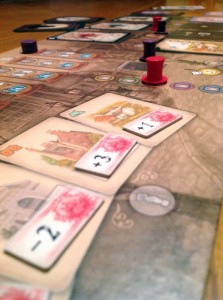
Your uncle has died. It’s sad but true. He has left you and the rest of the “family” an inheritance with the opportunity to have even more. Of course, there’s a catch. You have to be the first person to spend all of your money and own no properties in order to get the rest of the inheritance. Players will play cards to maintain properties, hire excessively expensive helpers, host lavish events, and have the most extravagant companion attend your festivities in order to eat into your pocketbook. Players will have to manage their collection of cards to spend the most money every turn. The first player to have no money or properties AND is the most in debt at the end of a round is declared the winner.
Components:
There are many components that come with Last Will. You have high quality boards used for every section of the game with a Victorian England setting that is clearly represented in the artwork. It’s a little more cartoony than I would expect, but it works quite well on the board and cards. I also like that they decided to go with circular pieces to represent the companion and player pieces. It doesn’t add to the experience in anyway, but it’s nice to have something else on the board instead of cubes. They also did a nice job of displaying a good deal of information on the cards without it feeling cluttered. I have nothing to complain about component-wise.
How to Play:
The are four major areas in the game. Player, planning, and errand boards are important, but the first thing players need to understand is the different type of cards available to them. There are four standard and two special types of cards that are used throughout the game.
The four main types of cards are:
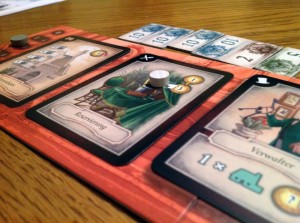
1. Events: These are one-time use extravagant outings. They can be made more expensive by using companion cards.
2. Helpers and Expenses: These cards are played on the player board. They allow you spend money each turn or make certain events more expensive. They also can grant a privilege that gives you special actions that you can choose to use on your turn.
3. Properties: Properties are a quick way to spend loads of money in the game in order to upkeep at the mansion, townhouse, or manor. Farms, on the other hand, get more expensive to maintain as you gain more animals.
4. Companions: These are dogs, horses, guests, or a chef. These are played with events or properties to make that card more expensive when activated.
The other two types of cards in the game are a group of special cards that have more powerful actions and events than in the normal deck of cards. The other type of card is a wild companion card that allows a player to choose the type of companion that card will be. Enough card talk, let’s talk about how Last Will is played.
At the start of the game, players get their own player board; two other boards are placed in the middle of the table. Players will get three property cards, three helper cards, and expenses cards, but they only keep two.
A round goes like this:
1. Setup: On the errand board, there are spaces for cards that need to be flipped over at the start of the round. These can be claimed later in the round.
2. Planning: Players will each take a turn claiming a spot on the planning board. This spot will determine four things for a player:
- Number of face down cards they will draw
- Number of errand boys they are able to play
- Number of actions they can use
- Turn order for the rest of the round
Each spot that a player can take has different values for each of these factors. Players must decide what they need that round and sacrifice the others. If a player gets any cards to draw facedown, they do it at this point. After all the players have taken their planning spots, the turn order for the round is set by the pieces placed left to right.
3. Errand: Each player will now play his or her errand boy(s) for different things. They can complete actions like drawing a random card, taking one of the face-up cards, adding another spot to place cards on their player board, adjusting the values of properties when they are bought and sold, or going to the opera to spend a quick two pounds.
4. Actions: During this phase, players are able to use the money-wasting abilities on the event cards in their hand as well as activate cards on their player board. Each player gets one turn to use as many cards as they want until they don’t have enough actions remaining. Players will need to optimize the limited number of actions in order to remain competitive versus the other players.
5. Clean-up: Any unclaimed cards on the errand board are now discarded and pieces returned for the next round. Players must discard down and hold only two cards in their hand. The first player token now moves to the left-side player. Play will continue until seven rounds have passed and the person who is most in debt or has the lowest money total wins the game. If, in any of the earlier rounds, a player is able to have no properties and money, that round will be the last one played.
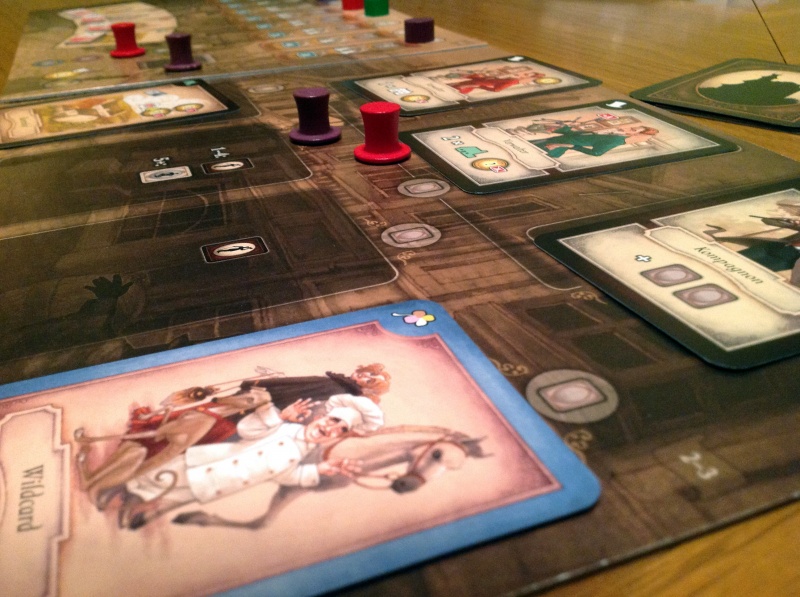
Game Experience:
Everyone I played this game with loved the theme because it was such a departure from other games they played. Weeks later, they were still talking about playing Last Will. When you first sit down, you have to rethink how you score points. In Last Will you want to find the purchases that are the most expensive. It takes some time to get used to it, but once you do, the game just clicks. The settings is also very vibrant; the Victorian England motif works quite well.
However, theme does not make a game. Luckily for us, the game play is on par with the theme. First, the game has two separate boards on which players will interact. This allows the game to have plenty of interaction between the players. During the planning phase, players will snatch up spots that other people covet and occupy spots ahead of people in the turn order. Similarly in the errand phase, people will take the action you want to take. It truly feels that you are fighting versus the others to gain the rest of the inheritance. In the games I played, people were getting into character and squabbling over moves. They were taking spots and cards that they didn’t want just to block another person from getting it. If having all this player interaction isn’t your thing, you’re in luck. There is also the player board, where you can build your own engine to spend money.
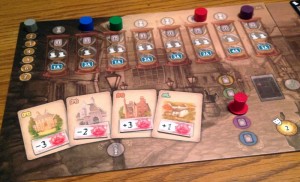
While playing the game, there also isn’t a lot of down time. While other players are taking planning and errand spaces, you must pay attention in case they take your ideal spot and have to adjust. The only time that drags a little is when people are debating about how to spend their actions. If you happen to be the last player in the round to play, you might be sitting there for awhile knowing what you are going to do, but just have to wait. Last Will is a game that plays great with higher player counts. This allows for more stealing of positions on the board and more overall player interaction. There is a two-player variant that works alright, but the game is much better when you have three or more players.
The player board is where the game is really won and lost. Every other part of the game is jockeying for resources, but here is where you spend your money. Last Will’s variety shines on the player boards. There is no set strategy to win this game every time. Every game, players will get new sets of different cards that they will have to work with to win the game. As you get different cards on the board, your strategy must adjust as well. For instance, if you happen to get a group of cards that allow you to spend more money when attending events that have a theater mask on them, you will be pulling event cards as much as you can. Making everything work in synergy like that is a lot of fun. While interacting with the player board, I almost felt like I was playing 7 Wonders. Looking at my collection of cards and figuring out what card would help me the best now and in the future. I also found that Last Will is a very tight game. Most of the time, everyone has roughly the same amount of money, making the last round very tense.
Despite how much fun I had playing the game, some of the people I played with didn’t enjoy it immediately. This game is not the first game I would bring out to a group of people not familiar with some of these game mechanics. At the beginning, the game can be very overwhelming. With all the bits, cards, and different type of boards, some of the players were intimidated to play. It also doesn’t help that on each of the cards, symbols depict the abilities of the cards. These can be very confusing to look at, as it is not clear what some of them mean. Within the rule book there is a helpful chart to explain each symbol, but it’s daunting when you look at them for the first time. I truly believe that if you are able to get past the visuals and start with the simple game play, a majority of people will have a fun time playing this game.
Final Thoughts:
I have played a few games published by Czech Games (Space Alert, Galaxy Trucker, Tzolk’in) and have enjoyed all of them. This trend continues with Last Will. I think that this game has a nice mix of worker placement and hand management that blends well with the theme throughout the game. The iconography on the cards and the scale of the game might intimidate some at the start, but if they are able to make it past that and allow for the game mechanics to shine through, they will enjoy this game. Last Will might not be the best game that I have played, but it is one that I will keep in my collection for a long time.
If you are interested in getting a copy for yourself, it’s about $38
Final Score: 3.5 Stars – A more advanced game that combines excellent game mechanics with a theme that is memorable.
 Hits:
Hits:
• Great theme
• High levels of player interaction
• Solid game mechanics throughout the game
Misses:
• Complicated symbols
• Game can be intimidating to new players







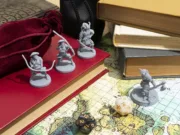















I’m in favour of anything which gets people thing about getting a Last Will – 70% haven’t even got an our of date one!
Is this game available in the UK?